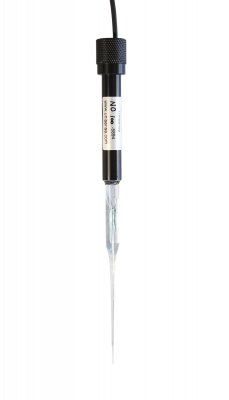Diffusivity and solubility of nitric oxide in water and saline
Zacharia, Ian G et al. (2005),
Annals of Biomedical Engineering,
vol. 33,
214-222
Zacharia, Ian G, Deen, William M, Zacharia, Ian G., Deen, William M. (2005),
Annals of Biomedical Engineering,
vol.
33,
214-222
Aqueous diffusivities and solubilities of NO were determined by using a chemiluminescence detector to measure time-dependent fluxes across stagnant liquid films confined between polydimethylsiloxane membranes. The NO diffusivities in pure water and PBS at 25°C were found to be (2.21 ± 0.02) × 10 -5 cm 2 s -1 and (2.21 ± 0.04) × 10 -5 cm 2 s -1, respectively. Although lower than most previous values for NO at room temperature, these diffusivities are very similar to those for O 2, as one would expect. Extrapolation to 37°C yielded a value of 3.0 × 10 -5 cm 2 s -1. The solubility of NO in water at 25°C was (1.94 ± 0.03) × 10 -6 mol cm -3 atm -1, in agreement with the literature. This agreement, along with the excellent fits obtained to the transient flux data (<4% rms error in each experiment), supports the validity of the simultaneously measured diffusivity. The solubility of NO in PBS at 25°C was (1.75 ± 0.02) × 10 -6 mol cm -3 atm -1. The modest (10%) reduction in solubility relative to that in pure water is consistent with the usual effects of salts on gas solubilities. © 2005 Biomedical Engineering Society.
10.1007/s10439-005-8980-9
The chemistry of the hydrogen sulfide and iron sulfide systems in natural waters
Morse, John W. et al. (1987),
Earth Science Reviews,
vol. 24,
1-42
Morse, John W., Millero, Frank J., Cornwell, Jeffrey C., Rickard, David (1987),
Earth Science Reviews,
vol.
24,
1-42
Reduced sulfur compounds are ubiquitous components of anaerobic sediments and euxinic marine environments. They are primarily produced through a complex net of both chemically and biologically mediated reactions. This results in a wide variety of dissolved and solid inorganic and organic products. Much of the recent research effort in this area has focused on biogeochemical interactions and modelling sediment diagenesis. Several excellent reviews are available on these specific topics. However, relatively little attention has been paid to more basic inorganic chemistry of this system; the topic of this review. © 1987.
10.1016/0012-8252(87)90046-8
The solubility of nitrogen, oxygen and argon in water and seawater
Weiss, R. F. (1970),
Deep-Sea Research and Oceanographic Abstracts,
vol. 17,
721-735
Weiss, R. F. (1970),
Deep-Sea Research and Oceanographic Abstracts,
vol.
17,
721-735
Recent precise data on the solubilities of nitrogen, oxygen and argon in distilled water and seawater are fitted to thermodynamically consistent equations by the method of least squares. The temperature dependence of the Bunsen solubility coefficient is treated using the integrated van't Hoff equation. It is shown that the Setchénow relation gives an adequate representation of the salting-out effect. Equations expressing the solubilities of these gases, as a function of temperature and salinity, in units of the Bunsen coefficient, ml/l., and ml/kg are given along with solubility tables in each of these units. © 1970.
10.1016/0011-7471(70)90037-9
Solubility Data Series
KERTES, A.S. et al. (1981),
Oxygen and Ozone,
vol. 8,
vi
KERTES, A.S., Battino, R.; Clever, H. L; Young, C. L. (1981),
Oxygen and Ozone,
vol.
8,
vi
Discrepancies between prenatal social support expectations and subsequent perceptions of support actually received were examined in relation to postpartum depression. Low-risk primiparous women (N = 105) were surveyed 1 month before and 1 month after delivery. Almost half of the women prenatally and one third postpartially had depression scores which would lead them to be classified as possibly depressed (CES-D scores of 16 or greater). In multiple regression, two social support discrepancy measures, prenatal depression and postpartal closeness to husband, correlated with postpartal depression and accounted for nearly 40% of its variance. The generalizability of the findings should be further explored, but the findings suggest the need for attention to prenatal expectations of postpartum support as a way to influence the incidence of postpartum depression. In addition, continued efforts to identify causes of postpartum closeness with the spouse are needed.
10.1016/b978-0-08-023915-6.50004-4















